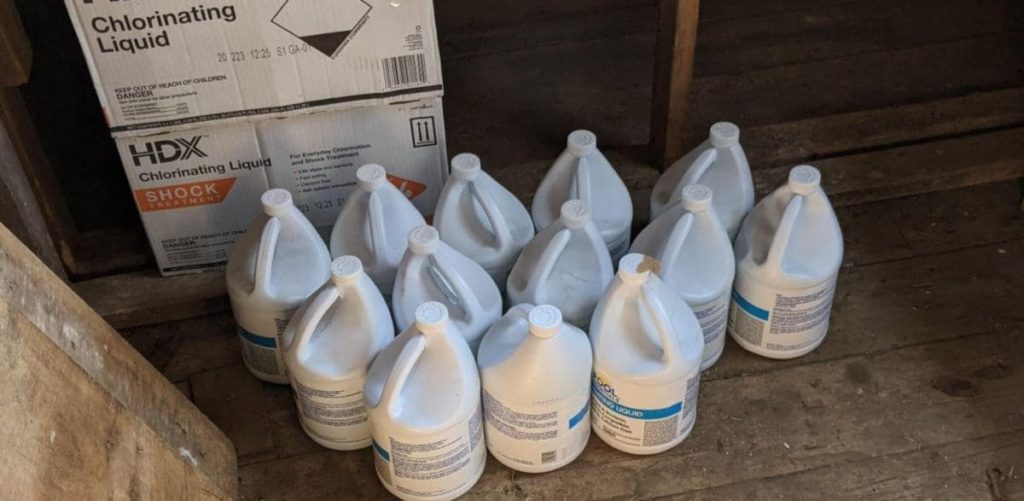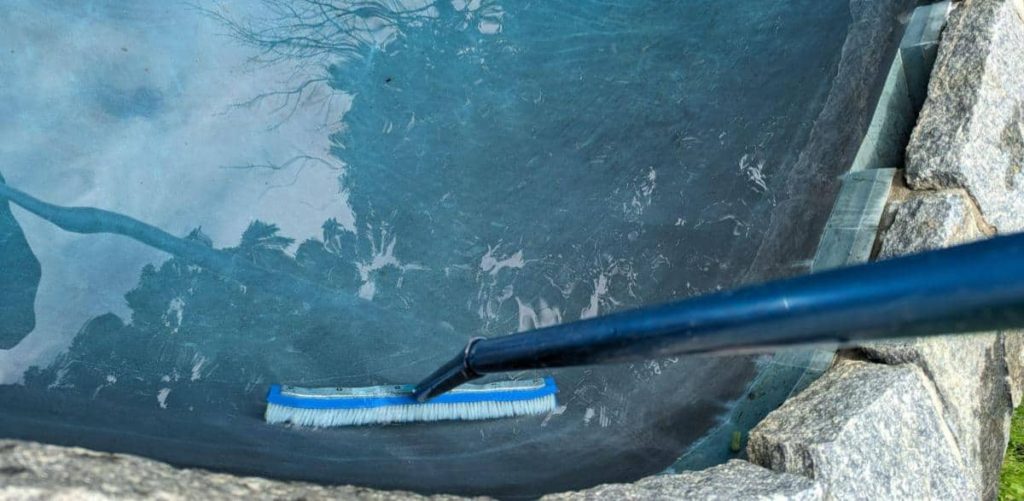One of the more common phrases that even non-pool owners may know is “shocking your pool.”
The process of “shocking” involves increasing the chlorine levels (FC) of your pool to eliminate any contaminates or organic bacteria living in the pool water.
You may see recommendations that shocking your pool weekly is necessary to keep it clean and free of contaminants.
While it seems like a good idea, the goal is never to shock your pool! I want to give you an alternate point of view.
When to Shock Your Pool
This may contradict what you read regarding pool shock, but it shouldn’t be a process in your weekly pool maintenance schedule.
If you have been diligent in pool maintenance and testing reveals all chemical levels are well balanced and clear of organics, why would you waste resources to shock your pool?
The process is only necessary if your testing reveals a water issue or an unforeseen event in your pool that requires extra sanitation. Specifically:
- Squirrels, rodents, or any wild animal that drowned in the pool
- Poop in the pool
Even after a big pool party with lots of water displacement and oils in the water, shocking shouldn’t be necessary. You’ll definitely need to add chlorine, but not at the shock levels!
Ultimately, the goal is never to have to shock your pool.
Steps to Shocking Your Pool
If testing reveals that you need to shock the pool, follow these steps to ensure it returns to a clear, swimming paradise!
Have A LOT of Chlorine Handy
You might want to stock up on chlorine since this is overloading your pool it. While there are different types of chlorine, liquid chlorine or bleach is highly recommended. It works fast and doesn’t add anything else to the water.

Calcium hypochlorite (cal-hypo) is a good substitute. As a matter of fact, if you buy”pool shock” in stores, it’s typically just cal-hypo. Do note that cal-hypo will also increase your calcium hardness (CH) levels.
Trichlor pucks are not recommended as they do not work as quickly as we want, and the pucks will increase your CYA over time. To be honest, using trichlor most likely got you into this mess in the first place!
Test The Water and Know Your CYA Level
You may see general recommendations to dump a pound of “shock” per 10,000 gallons of water and call it a day. However, that doesn’t make sense without knowing how much stabilizer is in the pool.
You may not need that much. On the other hand, you may need way more than that!
CYA will dictate how much chlorine is used to get the appropriate level of free chlorine (FC). Use an accurate water testing kit to check the current chemistry readings.
The most accurate and reliable pool testing kit.
Type of Chlorine Test: FAS-DPD
Read our full Taylor K-2006 Review.
Adjust your pH
Since you are adding a large amount of chlorine to the pool, lower your pH to about 7.2 – 7.4.
pH testing is largely unreliable when FC gets above 10. Shocking can take a few days to complete, so it is recommended to keep it at the lower end.
Add Chlorine based on your CYA Level
As stated above, your CYA level determines how much chlorine to add. CYA levels should be between 30-60 ppm.
According to Richard Falk, an approximate shocking range is about 40% of your CYA level, which would be the following:
| CYA (Stabilizer) in ppm | FC to Shock Level in ppm |
|---|---|
| 20 | 8 |
| 30 | 12 |
| 40 | 16 |
| 50 | 20 |
| 60 | 24 |
| 70 | 28 |
| 80 | 32 |
| 90 | 36 |
| 100 | 40 |
Use our pool shock calculator to know exactly how much chlorine you need based on your shock level.
If CYA is high, consider balancing it out before starting the process. As you can see above, you’ll need a lot of chlorine at higher CYA levels.
Continue Testing and Adding Chlorine If Necessary
You’ll want to maintain that chlorine shock level throughout the process. Chlorine dropping to lower levels before the water issue has been resolved can run the risk of potentially having to restart the process.
Test 3-4 times a day and add chlorine as needed.
Brush the Pool and Clean Filters as Needed
During the process, remnants of dead algae and organics may float in the pool. Continuously brush and vacuum the organics into the filter.

Depending on how much is in the pool, the filter may need to be backwashed or the grids cleaned. This is a good sign that the filter is catching all that bad stuff.
When is the Shock Process Complete?
There are three criteria to know if you have completed the process:
- The water is crystal clear, with no visible signs of algae or organics in the pool
- Testing reveals combined chlorine (CC) is 0.5 or lower. This will tell us if chlorine is still fighting something in the water.
- FC levels are maintained overnight, dropping less than 1 ppm
Step 3 shows us if contaminants are still eating up chlorine in the pool. Chlorine is consumed by two things: organic compounds and sunlight. Running this test overnight eliminates the sun as a factor of FC loss.
The process is pretty straightforward. Record your FC levels when the sun goes down. Next, record FC again before the sun comes up. Shocking is considered successfully done if FC drops less than 1 ppm.
If it is greater than 1 ppm, then, unfortunately, you still have something in your pool, and the fight continues.
Hopefully, Shocking is One and Done!
The process may seem long and tedious, and it can take many days to complete. However, once it is done, make sure it never needs to be done again.
Keep testing, and keep your water balanced, and enjoy the pool!

